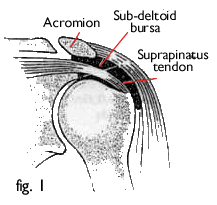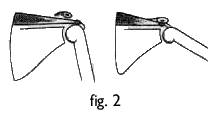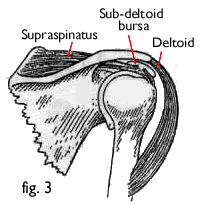

|
Back to |
| The Front Page |
| News & Features |

|
Croquet sports injuries: #2. Frozen shoulder by Bob Burnett, Dip RGRT, MSCP, SRP Chartered Physiotherapist Posted March 2, 2001 |
|
||||
Pathology of Frozen Shoulder
Bob Burnett, a Grade One coach and assistant referee, has for 20 years specialised in sports injuries at his private practice in Southport, England. This is the second in a series of articles originally published in the Croquet Gazette outlining the most common injuries affecting croquet players. They are not written for medics and do not contain a lot of detail. Their purpose is to give the ordinary player an insight into what may be wrong and the wisest course of corrective action. If the diagnosis is unsure or if symptoms persist, Burnett advises the injured player to seek a medical opinion. But in many if not most cases, wisely administered self-treatment is effective.
"Frozen Shoulder" describes the possible result of a variety of painful symptoms and conditions that may affect the shoulder. The word "frozen" refers to a lack of movement as a result of shortened muscles or adhesions surrounding the joint. These muscles shorten and adhesions occur after a period of enforced immobilisation following injury, such as shoulder dislocation or voluntary immobility due to pain.
Conditions which cause immobility due to pain, leading to Frozen Shoulder, include:
- 1. Capsulitis
- Capsulitis of the shoulder may result from a sprain in which the ball at the
top of the humerus is forced to move outside its normal range within the
socket of the shoulder. However, in croquet players it is more likely to
occur as a result of excessive use - such as might occur in a week-long
tournament playing three games a day. It is characterised by diffuse pain
in the joint, particularly during movement; the pain is difficult
to localise.
- 2. Supraspinatus tendonitis (painful arc syndrome)
- This condition is an inflamation of the supraspinatus tendon, (fig. l). This
structure is responsible for initiating the movement of the arm away from
the body. Although discomfort may be present at rest, this
condition is usually characterised by the pain on the tip of the shoulder
when the arm is moved sideways or upward above the head. The first 40
degrees are pain free; the arm then enters the 'painful arc' and pain
diminishes again at around 120 degrees. The pain is caused by the lesion on
the tendon rubbing under the acromion process during the middle section of
the arc (fig. 2).


- In some chronic cases, especially with the older player, ectopic
calcification (bone growth) may occur within the tendon. This will be
visible on X-ray and surgery may be required.
- 3. Bicipitaltendonitis
-
This is a problem similar to the above, but in this condition the inflamed
biceps tendon is running down a groove in the bone on the top of the arm.
Pain is felt on the front of the shoulder and top of the arm when it is
moved backwards and outwards. The pain is well localised and easily elicited
by palpation but on occasions may radiate down the arm into the biceps
muscle.
- 4. Sub-acromial bursitis
This condition is an inflamation and subsequent swelling of the sub-acromial (sub-deltoid) bursa (fig.3). The bursa acts to separate some tendons around the shoulder from the bony arch of the shoulder socket.
It can occur as a result of a direct impact injury, over-use, or in conjunction with other shoulder injuries, especially "painful arc" syndrome. It is characterised by a diffuse pain over the shoulder and a severe lack of mobility.
- 5. Periarthritis Osteoarthritis
- Periarthritis Osteoarthritis is common in the weight-bearing joints - the hips and knees - but quite rare in the shoulder joint. When degenerative changes do occur, they tends to manifest in the soft tissues; this condition is known as periarthritis. The joint aches and stiffens. Mobility and internal rotation are lost quite early.
Management and treatment
The golden rule for all painful shoulder syndromes that may ultimately result in a frozen shoulder is: Prevention is better than cure. Immobility for any prolonged period will result in stiffness. If this stiffness is not addressed, a frozen shoulder may result.
In the acute stage of all the above conditions, it is important to strike a balance between too much movement - which will cause increased inflamation and a worsening of the condition; and too little movement - which will lead eventually to a frozen shoulder. Gentle pendular swinging exercises with the arm should be performed for a few minutes a couple of times each day. This will gently mobilise the soft tissue structures around the shoulder and increase circulation without inflaming the condition.
As the acute inflammation subsides, the movements may be increased and gravity may be utilised to provide resistance to the muscle contractions. It is still important at this stage not to perform any movements that cause pain or an increase in the level of discomfort. All the various movements of the shoulder must be attempted, not forgetting rotation, as this is often the most stubborn. The "good" arm may be used to assist the affected arm into positions it finds painful to attain unaided. It must be stressed that activities which increase inflammation and cause pain on movement should be avoided.
Other forms of treatment at this stage include: painkillers, anti-inflammatory medication, hydrocortisone injections and physiotherapy.
As the condition Improves, greater ranges of movement are used in the exercises performed together with stronger and faster muscle contractions. If the movements of the shoulder have been maintained throughout, a frozen shoulder will not develop. The condition should progressively respond to treatments and return to normal.
In the unfortunate event of a chronic frozen shoulder developing, vigorous mobility exercises must be performed to stretch the muscles around the shoulder and to break down adhesions that may have formed. In stubborn cases a manipulation may be required, possibly under anaesthetic, or surgery will sometimes be needed to perform a decompression or remove unwanted bone growth.
The longer a shoulder has been "frozen", the more difficult it is to reestablish normal movement. So remember: "Prevention is better than cure." Don't let your shoulder stiffen in the first place.
Reprinted by permission of the Croquet Gazette.